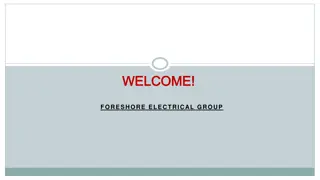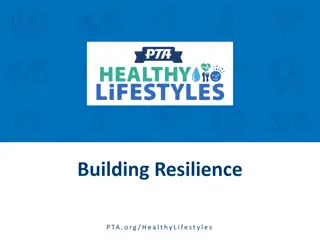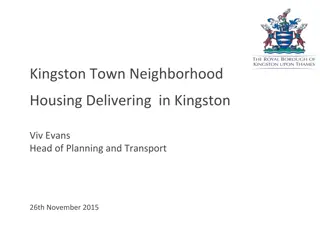Kingston System Resilience Group Overview for Health Planning 2014/15
The Kingston System Resilience Group (SRG) was established to enhance the delivery of urgent care services and improve patient experience within the Kingston health economy. Comprising various stakeholders, the SRG focuses on addressing system pressures, determining service needs, and implementing operational changes to ensure whole system improvements. Through collaborative efforts and operational planning, the SRG aims to achieve high-quality services and system resilience, thus providing effective care year-round.
Download Presentation

Please find below an Image/Link to download the presentation.
The content on the website is provided AS IS for your information and personal use only. It may not be sold, licensed, or shared on other websites without obtaining consent from the author.If you encounter any issues during the download, it is possible that the publisher has removed the file from their server.
You are allowed to download the files provided on this website for personal or commercial use, subject to the condition that they are used lawfully. All files are the property of their respective owners.
The content on the website is provided AS IS for your information and personal use only. It may not be sold, licensed, or shared on other websites without obtaining consent from the author.
E N D
Presentation Transcript
Winter Planning 2014/15 RBK Health Overview Panel
Kingston System Resilience Group Kingston Urgent Care Working Group Part 1 The creation of Urgent Care Working Groups (UCWGs) in 2013/14 brought together all parts of Kingston s health economy and social care systems to co-develop strategies and plans to provide, and where appropriate integrate, safe and efficient urgent and emergency services for patients, creating a resilient whole system to deliver the 4 hour A&E target over winter. In response Kingston UCWG was set up consisting of Kingston, Richmond, and Surrey Downs CCGs, Kingston Hospital Foundation Trust (KHFT), Kingston and Richmond local authorities and community services, LAS, Staywell (formerly Age Concern Kingston), NHS 111 & Out of Hours (OoH), and Health Watch representative In Summer of 2014 their role was expanded to cover both elective as well as non- elective care, and the name changed to System Resilience Groups (SRG), because: Bringing together both elements within one planning process underlines the importance of whole system resilience and that both parts need to be addressed simultaneously in order for local health and care systems to operate as effectively as possible in delivering year-round services for patients. It is imperative that resilience is delivered while maintaining financial balance. There can be no trade- off between finance and performance. Tripartite Group.
Kingston System Resilience Group Kingston Urgent Care Working Group Part 2 The goals of the SRG are to enable urgent care systems to determine appropriate arrangements to delivering high quality services and improving patient experience. The focus of the SRG is to: Determine service needs to Kingston Health Economy Initiate local changes needed Address issues that have previously hindered whole system improvements. SRGs are responsible for Systems Resilience/ UCWG Operational Plans Completion and sign of Winter Planning Checklist Monitor urgent care system, providing SRG and system accountability through key performance indicators Based on performance carry out targeted analytical reviews of the drivers of system pressure, and agree actions to manage these and mitigate Agree on the application and monitor the use of central non-recurrent funds for systems resilience
Kingston System Resilience Group Kingston Urgent Care Working Group Part 3 Agree operational changes across health and social care services to meet system pressures by determining local service needs, initiating local changes needed, and addressing issues that have previously hindered whole system improvements System accountability through key performance indicators Build sustainability and early warning systems to identify system constraints Develop and implement an agreed communications plan. Make recommendations to member organisations Produce reports as required to member organisations and Tripartite/ NHSE London Region Ensure read across between all SRGs in Richmond, Surrey Downs and Kingston Share learning and good practice across organisations and urgent care system Kingston UCWG/SRG is accountable to Kingston CCG s Integrated Governance Committee (IGC), and provides assurance to the Tripartite Group: Monitor, Trust Development Agency (TDA) NHE England, and Directors of Adult Social Services (ADASS)
Overview of Current Services Part 1 Kingston Hospital A&E good service, keeps to 4hr target, good conversion rate, attendances increasing (except decrease in 2013/14), admission rates deceasing and stable Financial Year Weeks Reported % Conversion Rate Emergency Admissions A&E Attendances 4-hour wait performance Number 10,466 16,989 18,209 20,554 21,008 18,477 19,014 15,490 16,574 17,221 17,361 17,103 16,445 9,108 Yearly total 16,492 16,989 18,209 20,554 21,008 18,477 18,655 15,490 16,574 17,221 17,361 16,780 16,445 14,895 % change Number 53,639 85,737 92,964 98,072 99,359 101,353 104,787 105,769 109,402 109,237 112,230 115,427 110,016 68,760 Yearly total 84,522 85,737 92,964 98,072 99,359 101,353 102,810 105,769 109,402 109,237 112,230 113,249 110,016 111,699 % change 2001/02 * 2002/03 2003/04 2004/05 2005/06 2006/07 2007/08 2008/09 2009/10 2010/11 2011/12 2012/13 2013/14 2014/15 * * Numbers are extrapolated utilising annual profiles based on historic activity. Source: A&E Weekly Sitreps and Kingston Daily A&E returns. 33 52 52 52 52 52 53 52 52 52 52 53 52 32 19.51% 19.82% 19.59% 20.96% 21.14% 18.23% 18.15% 14.65% 15.15% 15.76% 15.47% 14.82% 14.95% 13.34% 3.01% 7.18% 12.88% 2.21% -12.05% 0.96% -16.97% 7.00% 3.90% 0.81% -3.34% -2.00% -9.42% 1.44% 8.43% 5.49% 1.31% 2.01% 1.44% 2.88% 3.43% -0.15% 2.74% 0.91% -2.85% 1.53% 96.08% 97.43% 97.87% 97.61% 98.06% 98.12% 98.15% 97.06% 96.44% 95.71% 95.63% Latest Data: 09-Nov-14 SE CSU: SWL A&E Performance Quarterly 2012/13 2013/14 2014/15 Provider Croydon Epsom and St. Helier Kingston St George's South West London Q1 94.29% 97.80% 96.53% 96.87% 95.28% Q2 94.98% 97.81% 97.00% 96.16% 96.45% Q3 96.09% 96.18% 96.13% 95.14% 95.85% Q4 92.77% 95.62% 95.96% 95.52% 94.95% Q1 95.42% 94.51% 95.67% 94.99% 96.16% Q2 96.55% 94.99% 95.94% 94.44% 96.29% Q3 94.11% 95.20% 95.11% 93.35% 95.42% Q4 95.26% 96.48% 94.92% 92.89% 95.85% Q1 95.09% 96.46% 95.45% 94.89% 95.48% Q2 95.63% 96.41% 95.77% 95.18% 95.74% Q3 (QTD) 93.98% 95.81% 95.97% 94.16% 94.98%
Overview of Current Services Part 2 Kingston still has challenges - over the winter period 2013/14 and during this summer 2014 KHFT has intermittently missed the A&E target during the week, despite lower attendance rates. A review of KHFT A&E attendances showed: KHFT are dealing with a richer A&E case mix with sicker patients requiring resus (greater acuity) and/ or with greater complexity Intermittent staffing problems in emergency department - doctors and nurses shortage due to illness or issues with recruitment, etc. Bed availability issues across London, e.g. paediatrics Delayed transfer of care (DTOC) challenges getting people out of hospital safely back to their home or into a step down bed.
Overview of Current Services Part 3 GP surgeries with extended hours and weekend/ bank holiday working over winter 2014/15 via cluster model of 4 GP Practices seeing patients from all Kingston GP Practices via appointment or walk in system GP led Health Care Centre in Chessington NHS111 difficult start, now achieving call answering target, improving on clinical call transfers navigating people to the right urgent care service Care UK Out of Hours service (OoH) Minor Injuries Unit Teddington/ Roehampton Your Healthcare CIC services - Rapid Response Team, Nursing Home services, etc. Kingston at Home Social Care Pharmacies, Dentists & Opticians
A&E Survey Findings A&E Survey (carried out over 2 weeks in Nov. 2013) A&E attendances begin to increase rapidly from 07:00 am, reaching its peak at about 12:00 pm. Also Saturday/Sunday/Monday were the busiest period of the week with a spike on Saturday afternoon. Circa 63% [231] of patients attending A&E, who were surveyed, lived within a 5 mile radius of Kingston Hospital. The largest group reside in the K3 area (within 1 mile of Kingston Hospital). Circa 19% [69] of people attending A&E lived within a mile radius of Kingston Hospital. Majority of the A&E Survey were filled out by age group of 25 to 64 (25-34 being the highest with 76 returns). Returns by Ethnicity, White/ White British Ethnic Group 75.27%, Asian/Asian British with 9.34%. As expected Over 50% of the survey return suggested the main reasons as to why people attend A&E were: Pain/Symptom became worse and/or condition was not improving Felt it was best place to get medication treatment/opinion High proportion of the returns revealed Minor Limb Trauma as the most likely problem as to why people who completed the survey decided to attend A&E. Key result of the A&E survey is that Kingston CCG: Will undertake targeted communications/marketing campaign 2014/15 to persuade people only go to A&E when it is an emergency, and when just urgent to call NHS 111 Has set up a GP weekend/bank holiday service where 4 GP Practice sites will be open and run by GPs offering appointments for patients register with Kingston GP Practices, reducing pressures on A&E
What Worked Well 2013/14 & to Deliver 2014/15 Part 1 Winter 2013/14 review identified key successes and improvements that need to be built on in winter 2014/15 plans to ensure greater operational resilience in the urgent care system and delivery of A&E target: Ensure urgent and emergency care services (primary care such as GPs and Pharmacists, community care, social services, Kingston hospital and voluntary sector) are working together and integrated where possible to ensure: Build on developments that allow patients to be treated at home or in the community with the right care package in place for those that need them, reducing avoidable A&E admissions and attendances Patients are safely discharge from hospital quickly and earlier in the week to the right place whether back to their home or a community service or nursing/ care home Put in place weekend working (shift to 7 days a week working) of those services who usually work Monday to Friday only e.g. social workers, discharge co-ordinators, therapists (hospital and community), psychiatric liaison, etc. Urgent care providers winter planning meetings to improve working across boundaries, communications and to help resolve operational issues to improve urgent and emergency system performance
What Worked Well 2013/14 & to Deliver 2014/15 Part 2 Greater provision in primary care to support the urgent care system Senior hospital clinical decision making (medical) especially at weekends to facilitate patient management. Development of schemes that improve patient flows and journey within the hospital Timely, targeted and cohesive communications, e.g. Not A&E campaign Work with NHS 111 to support urgent care system SE CSU - SWL Pressure Monday Update and Weekly Conference Calls (more frequently when required) - resumed from November 2014 Regular A&E Situation Reports (Sitreps) and performance briefings Continue to improve information systems and reporting
Escalation Processes NHS England Escalation process 1 for missing A&E target We have surge management policies and SWL agreed escalation management process in place when all health systems are under pressure (CMS alerts red and black) This also includes trigger points for surge support when the health economy is under pressure. SE CSU also monitored pressures before the red and black triggers are breached, proactively acting as the system pressure begins to increase
Winter System Resilience Schemes 2014/15 Part One Kingston CCG in 2014/15 was allocated by NHS England 1,670,032 to support the whole urgent and emergency care system In addition both Richmond CCG and Surrey Downs CCG in addition to their own area schemes have allocated money to support Kingston s urgent and emergency care system for their patients using Kingston A&E The following schemes were developed, approved, and funded by the above money, by Kingston UCWG/ SRG to provide greater urgent & emergency care system resilience across primary, community health and social service, secondary care and voluntary sector, as well as LAS to ensure delivery of A&E target and minimise escalations . Whole System KCCG only 1,962,652 1,670,032 Kingston CCG total system resilience fund Total Bids VALUE ( ) [B]. VALUE ( ) SCHEMES High Impact Intervention KCCG Access to GPs at the weekend/ bank holiday or extended hours in the week 350,000 350,000 Admissions & Attendance Avoidance Schemes
Winter System Resilience Schemes 2014/15 Part Two Winter System Resilience Schemes continued: Total Bids VALUE ( ) [B]. VALUE ( ) SCHEMES High Impact Intervention Kingston Hospital Foundation Trust A number of schemes to increase senior consultant support and other healthcare professionals to suppport patient flows and discharges through the emergency department, and. 583,600 320,980 Improvements to systems flow through 7 day working/ DTOCs/ High Risk Groups Escalation Beds 539,560 539,560 Kingston Hospital Foundation Trust total Your Healthcare 1,123,160 860,540 Provide iIntegrated and rapid response services, including a paramedic and rapid response nurse in a car to respond to urgent calls, and 197,956 197,956 Improvements to systems flow through 7 day working/ DTOCs 89,083 89,083 Admissions & Attendance Avoidance Schemes/ High Risk Groups 287,039 287,039 Community Nursing Your Healthcare total
Winter System Resilience Schemes 2014/15 Part Three Winter System Resilience Schemes continued: Total Bids VALUE ( ) [B]. VALUE ( ) T. Ref SCHEMES High Impact Intervention Royal Borough of Kingston 20,000 20,000 Improvements to systems flow through 7 day working/ DTOCs 16,271 16,271 Admissions & Attendance Avoidance Schemes/ High Risk Group 36,271 36,271 6.1 Extended Social worker service 14.1Short-term specialist assertive outreach provision for people with dementia Royal Borough of Kingston total South West London & St Georges MHT 89,630 59,630 Improvements to systems flow through 7 day working/ DTOCs/ High Risk Groups 89,630 59,630 7.2Psychiatric Liaison service South West London & St Georges MHT total Age Concern Kingston 4.5Stay Well at Home & Telephone advice and in- touch service Age concern Kingston total 39,350 39,350 Admissions & Attendance Avoidance Schemes/ High Risk Groups 39,350 39,350 LAS Contribution to support their service winter resilience 37,202 37,202 KCCG Whole System 1,962,652 1,670,032 GRAND TOTAL LAS Contribution to support their service winter resilience - - Kingston CCG 1,670,032 Richmond CCG 187,572 Surrey Downs CCG 105,048 Total 1,962,652 RCCG = 160,000 for KHFT and 30,000 for SWL StG MHT bids
Outcomes Part 1 Urgent & Emergency Care system that is resilient and fit for purpose, ensuring the delivery of the A&E target in 2014/15 Improved patient satisfaction with KHFT s A&E and other urgent care services Reduction in bed based resources with a simultaneous increase in self care, primary care, and community health and social care to support care closer to home and to prevent urgent care needs from arising or people unnecessarily accessing A&E Increase A&E clinical staffing capacity to effectively manage demand and flow in A&E Improved discharge planning with move to 7-day working, regular MDT meetings and improved communication with health & social care teams Improve timely, same day access to general practice for urgent care - GP extended hours and weekend working via cluster/ federated model Expansion of community based alternatives; and admissions avoidance schemes including risk stratification to support at risk patients, MDT care packages and working, Kingston at Home service, community nurses, rapid response team, integrated response service, etc. improved healthcare professional access to advice to senior clinical consultant decision makers via Acute Care Physician (ACP) service Initiatives to support effective discharge such as discharge lounge, increased pharmacist support to provide medicines ready for discharge, step down measures (develop discharge to access) with priority to discharge to home when safe
Outcomes part 2 Urgent & Emergency Care system that is resilient and fit for purpose, ensuring the delivery of the A&E target in 2014/15 Effective provider winter planning meetings to resolve issues as they arise and make improvements Joined up care outside and in hospital working across organisational boundaries 7 day working for essential services and support services Increase patients treated at the scene such as the paramedic and rapid response nurse service and general rapid response team service Effective NHS 111 with a fully developed Directory of Services Ensure routine and consistent equality data collection, monitoring and analysis at all urgent care access points and implement changes as a result Pro-active identification and case management of frequent attenders/ admitters at A&E by GPs and locality community teams Improved use of 3rd sector services such as Staywell (formerly Kingston Age Concern) - staywell and handyman schemes Improved communications to the public via effective marketing of Not A&E campaign , as well as to staff and patients and providers across the urgent care health economy/ system Support MH patients at A&E via the 7-day Psychiatric liaison service at KHFT
Questions? Urgent and emergency care services are connected into a cohesive network so the overall system is more than just the sum of its parts.























